
каталог электронный
.pdf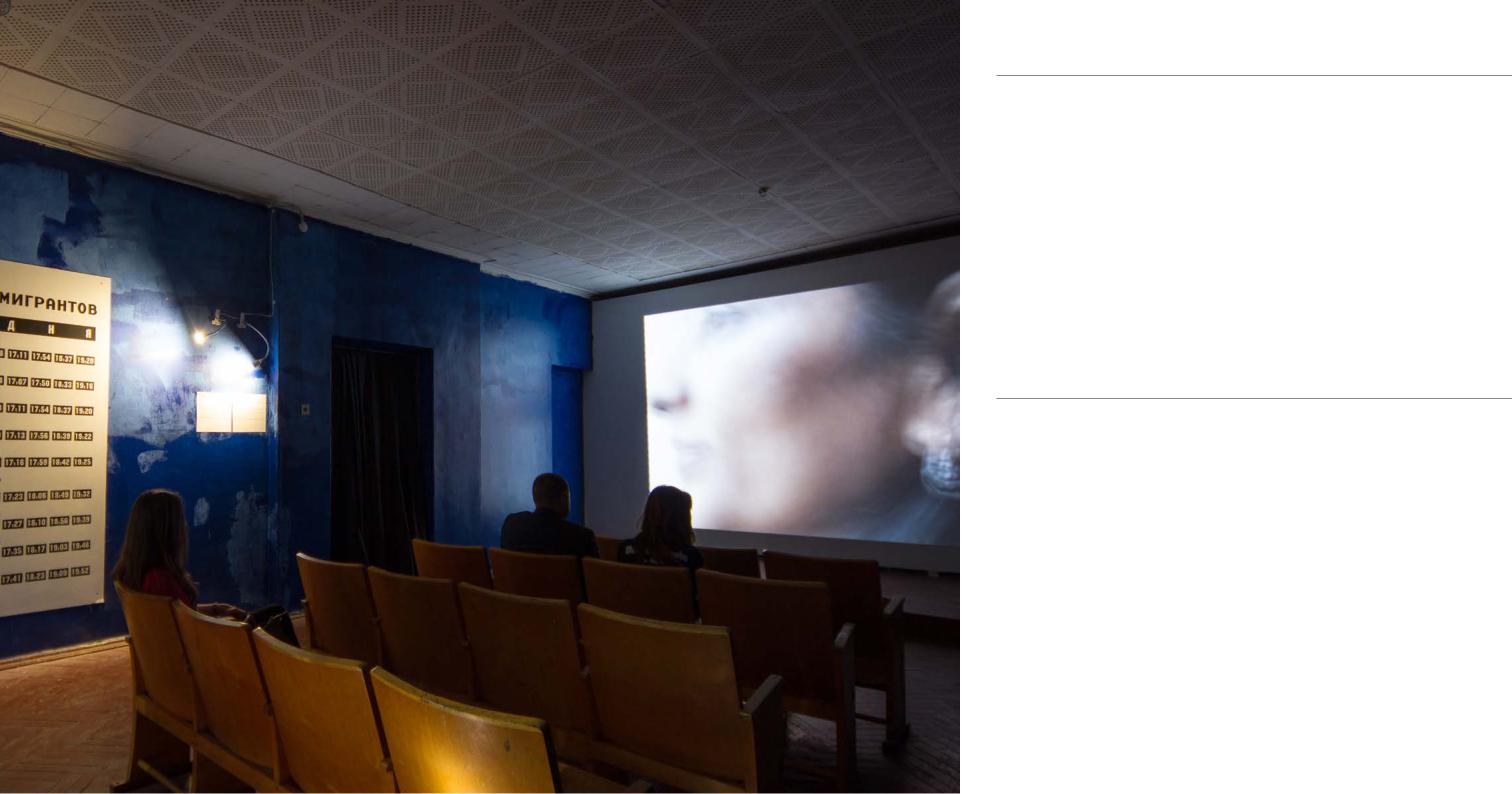
Таисия Круговых / Taisya Krugovykh
Таисия Круговых о своем проекте: «Я сняла это потому, что я говорю на одном языке, но молчу на сотне из них. Эмиграция – это выезд из страны с целью дальнейшего там проживания, иммиграция – это приезд в страну на постоянное место жительства, а миграция – это временное переселение внутри или за пределами страны. Кинотеатр для мигрантов – это не передвижной кинотеатр, как на первый взгляд может показаться. Скорее наоборот, это стационарный кинотеатр для передвижников: для передвигающихся в темноте кинозала лиц неопределенной национальности. Вскоре они обретут национальность, свой язык и традиции. Обретение происходит через язык ввода, он является проводником между залом, кинотеатром и городом Москва. Язык ввода в кинотеатре можно выбрать в подменю. На сегодняшний момент у нас представлено девять языков».
Родилась в 1981 г. в Судане. Каждый посетитель экспозиции «Кинотеатр для мигрантов» выбирает любой из девяти мини-фильмов о мигрантах в Москве. Герои короткометражек – гастарбайтер из Таджикистана, горничная из Индии, поэт с Фарерских островов, музыкант из Осетии, таксист из Грузии и другие – говорят и на русском, и на своем родном языке, помогая режиссёру составить для зрителя краткие словари.
Taisya Krugovykh about her project: «I filmed this because I talk in one language but am silent in hundreds of them.Emigration is the necessary departure from a country with the goal of living in your final destination. Immigration is the arrival
into a country with the aim of living there permanently, and migration is the temporary resettlement within the borders of one country or abroad. The theatre for migrants is not a transitioning theatre as it may seem at first. It is actually quite the opposite, it’s a fixed theatre for those in transition, for those moving through the darkness of the movie theatre, who’s faces we cannot pin down to a particular nationality. Soon they will find their nationality in our eyes, their language and traditions. This process happens through the act of choosing a language. This choice becomes the link between the theatre space, the movie theatre and Moscow. The language can be chosen through the sub-menu. At the moment there are nine languages to choose from».
Born 1981 in Sudan. Every visitor of the exhibition “The cinema for migrants” becomes a movie viewer for a while and is presented with the option of choosing one of 9 mini-films about migrants in Moscow. The heroes of the short films are a migrant worker from Tajikistan, a nanny from India, a poet from the Faroe Islands, a musician from Ossetia and a taxi driver from Georgia, as well as others. They all talk in Russian as well as their native tongue, helping the director to create a dictionary for the viewers. According to Taisya Krugovykh her work is aimed at helping break the language and psychological barriers between city dwellers and migrants.
Кинотеатр для мигрантов / The cinema for migrants
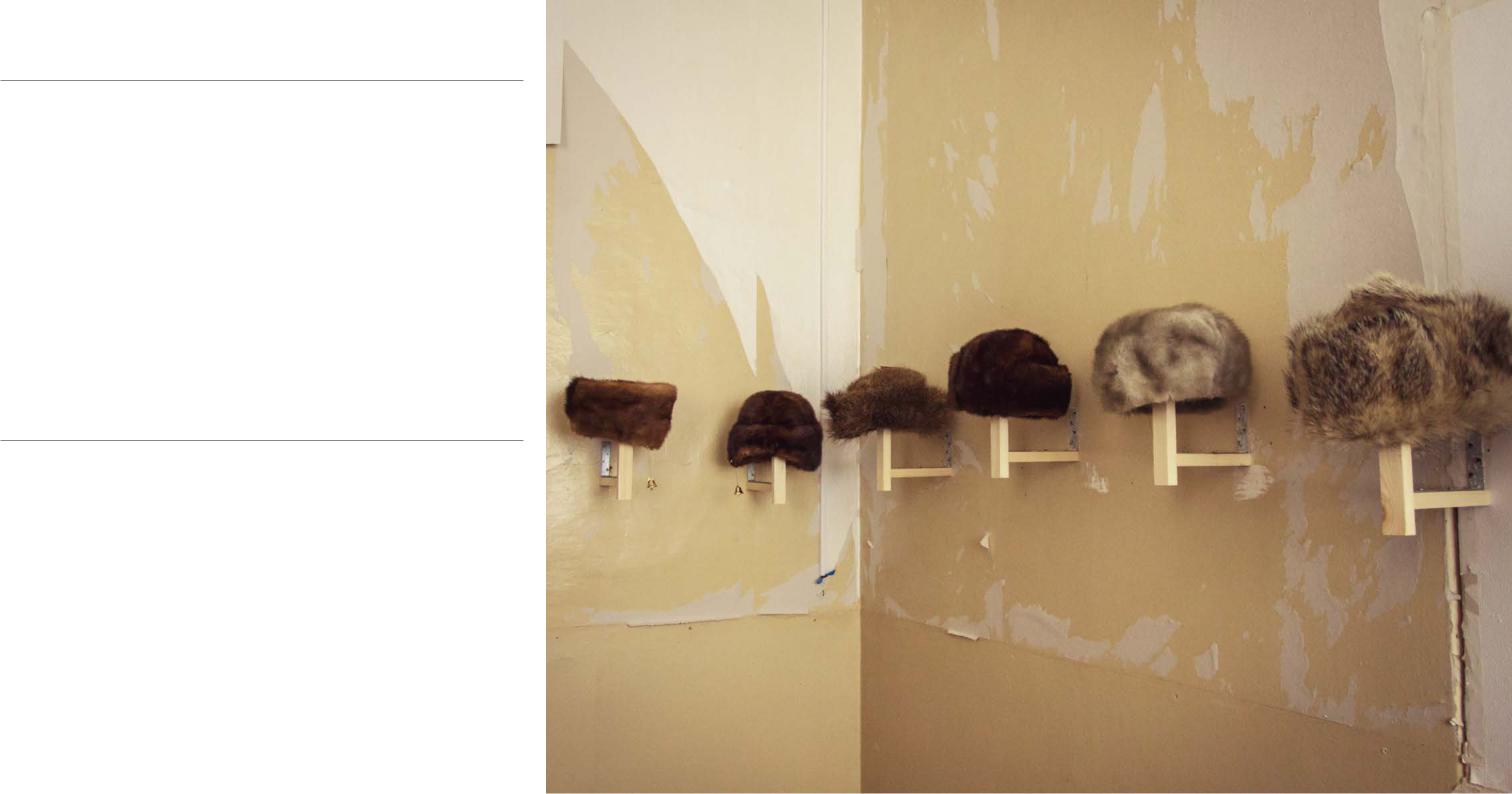
Игорь Самолёт / Igor Samolet
Игорь Самолёт о своей работе: «Идея этой выставки родилась после прослушивания «Удивительного вальса» Дольского. Мелодия вызывает у меня ассоциации с Ленинградом, где дуют северные ветра, где холод и метель. В этом звуке, вальсе толпы можно распознать шум суеты и спешащих на работу ранним зимним утром людей в шапках, каждая из которых рассказывает свою историю и кружится в общей метели человеческих судеб. Это история про абсолютно другое поколение, олицетворяющая коллективное участие в их общей человеческой
судьбе. Шапки передавались из поколения в поколение, как семейные реликвии. Но сейчас настали другие времена, старые вещи никому не нужны, магазины ломятся от товаров, наступила эпоха потребления. Шапки, которые кружатся в медленном вальсе, куплены мной на барахолках, обретя новую жизнь».
Родился в 1984 г. в Котласе. Инсталляция Игоря Самолёта «Вальс» построена на аллюзиях к советскому прошлому Санкт-Петербурга. 25 кружащихся в ритме вальса старых меховых шапок, найденных автором на барахолках, создают романтическую атмосферу ностальгии по Ленинграду. Автора вдохновили песни Александра Дольского «Удивительный вальс» и Аллы Пугачёвой «Ленинград» – ноты этих мелодий будут висеть на стенах выставки, но звучать будет шум северных вьюг и метелей. В этом звуке слышны шорохи городских улиц и голоса спешащих на работу ранним зимним утром людей в шапках, каждая из которых рассказывает свою историю и кружится в общей метели человеческих судеб.
Igor Samolet about his work «I was inspired by Alexander Dolskoy’s song “The amazing walse”. It reminded me of Leningrad, with the sounds of the Northern winds and storms. These sounds consist of urban chimes and the voices of those hurrying to work on a crisp winter morning. This is a story about a different generation, a collective presence in the mutual human destiny. These hats were passed on through generations, becoming the memories of a long gone Soviet history. Now they are not needed anymore as the times have changed, and shops are full of old things in the time of consumption. The second-hand hats bought by me are dancing in a slow waltz to find a new life».
Born 1984 in Kotlas. The installation “The valse” by Igor Samolet is based on the allusions of Saint Petersburg’s Soviet past. 25 woolly hats, dancing the rhythm of a waltz, were found by the artist at flea markets in the city. The artist was inspired by Alexander Dolskoy’s song “The amazing waltz” and by Alla Pugacheva’s “Leningrad’. The notes from these melodies will be presented on paper, but the sounds will be from the Northern winds and storms. These sounds consist of urban chimes and the voices of those hurrying to work on a crisp winter morning. Each of them tells the story of human destiny. These hats were passed on through generations, becoming the memories of a long gone Soviet history.
Вальс / The valse
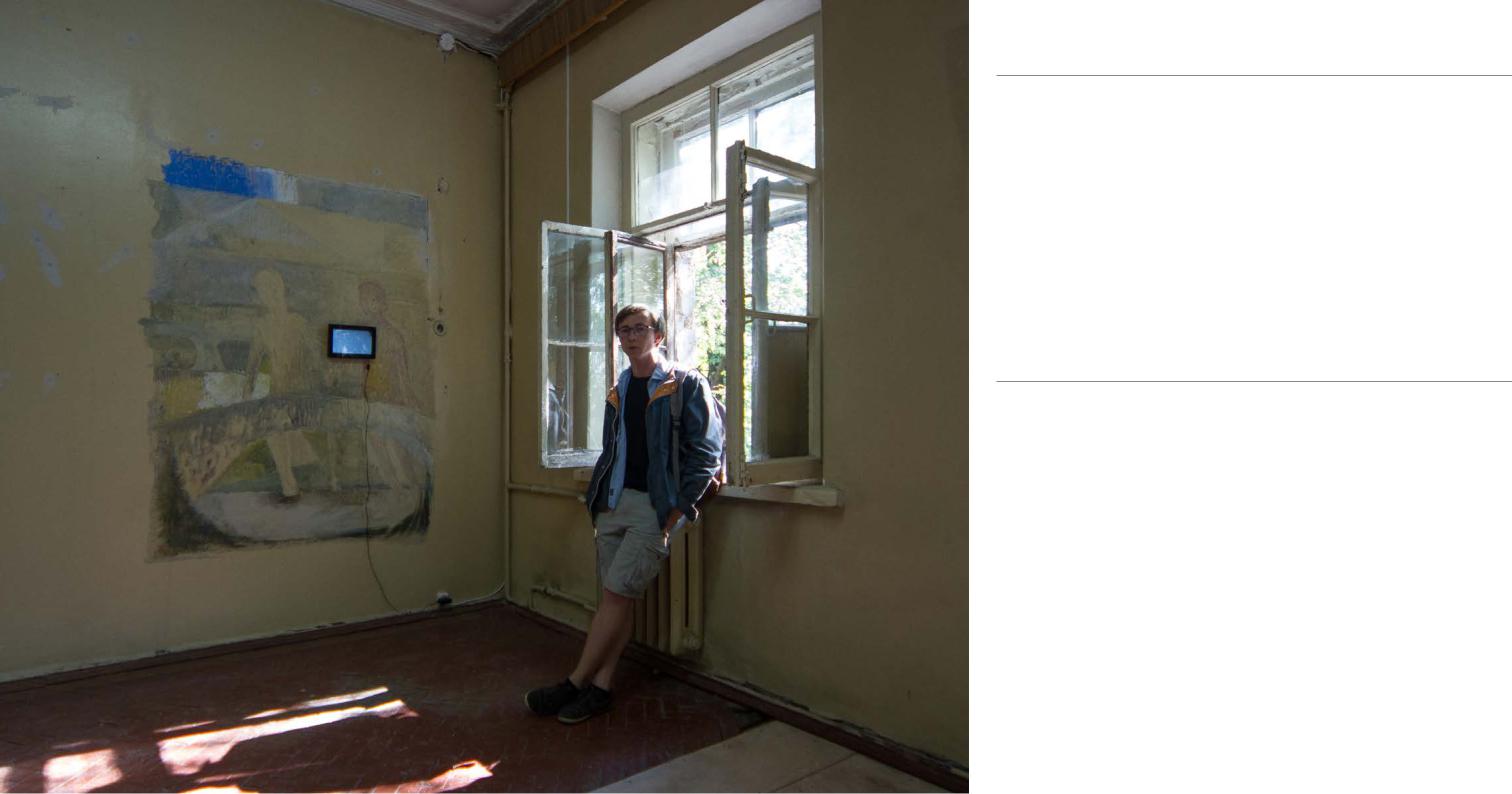
Кирилл Макаров / Kirill Makarov
Кирилл Макаров о своем проекте: «Пространство в какой-то степени преподносит само себя, не подменяя восприятие схематичным изображением того, что нужно увидеть. Легкое касание, формально ослабленное визуальное действие, создает координаты для восприятия, определяющие пространственные уровни, обозначает направление в пространстве. Это направление узнавания привычного визуального поля, низводящего образ до уровня известных вещей, набора данных и определяющее возможности их соединения. Мне интересно создание условий, которые могут служить мембраной между тем, что уже само по себе существует в пространстве, и пробуждающимся опытом».
Родился в 1988 г. в Ленинграде. Картины Кирилла Макарова, представленные на выставке «2» в 2013 г., обладают почти гипнотическим воздействием на зрителя – при всей простоте сюжетов и условности персонажей в них присутствует свойственное работам классических живописцев чувство цвета и формы. В своих интервью художник отмечает, что изобразительное искусство не нуждается в
объяснениях и комментариях, поэтому работам присвоен номер. В рамках выставки Generation START художник представит свой новый проект «Просторная комната».
Kirill Makarov about the project: «The space puts itself forward, clear from the schematic image of what needs to be viewed. The soft touch of the formal visual act creates coordinates for viewing the space on a certain level and a certain vector. This vector of recognizing a visual code, of the transition of image to a recognizable thing, a set of information and the opportunity for links in between. I am interested in the parameters needed to be a membrane between that which exists in the space and that which creates experience».
Born 1988 in Leningrad. Kirill Makarov’s paintings presented as part of the “2” exhibition in 2013 have a hypnotic effect on the viewer – although the themes are quite simple and characters hazy, the works are made with techniques that can be found in classical painting practices. A woman at the mirror, a toy horse, a pair of lovers looking at the sunset, all of these images seem trivial, but leave a feeling of depth and meaning. In his interviews the artist talks about the idea that visual art does not need commentary, and in his own work he does not use phrases, but rather gives them a unique number, just as the name of the exhibition is simply a number.
Просторная комната / The spacious room
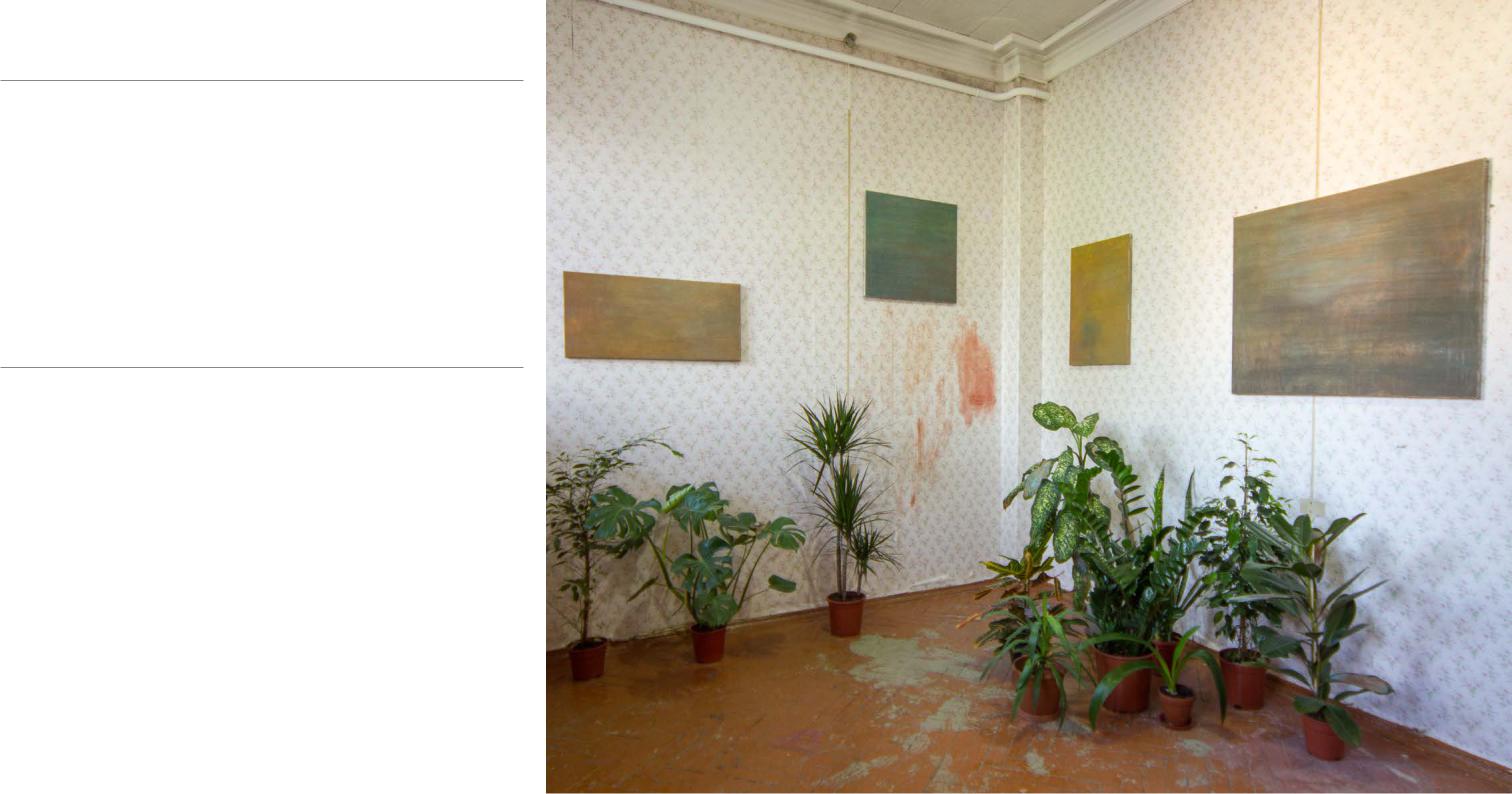
Иван Новиков / Ivan Novikov
Иван Новиков о проекте: «Будущее сегодняшних художников зависит от их способности оценить природу не в контексте борьбы и освоения, глазом флориста или специалиста по икебане, а на равном себе уровне. И каждый художник сам выбирает тактику расчеловечивания своего творчества. «Биоартистизм» замкнутых природных миров по-новому ставит вопросы живописи, вопросы ее человечности. Живопись, свободная от человеческой власти, полностью слившаяся с таинственной природой, стратегии которой будут раскрывать себя и после пребывания человека на земле».
Born 1990 in Moscow. In his “Untitled” Ivan Novikov explores the relationship between nature and art. By dissecting the relationship of the artist and the surrounding environment, he forces us to look at the human world, with it’s sociality and need for skills, as merely a part of something bigger. According to the artist, creativity cannot enslave reality any longer, creating aesthetic violence. Rather, art should check itself to try and find it’s place alongside the surrounding environment. Art should present itself as an object, paint nature as nature itself paints. Ivan Novikov will present his new project “Project with plants” for Generation START.
Ivan Novikov about his work: “The future of todays artists depends on artists looking at nature not as something to conquer, not through the eyes of a florist or ikeban specialist, but as equal to themselves. Every artist must choose his or her tactic to dehumanize their art. “Bioartisicm” of closed natural worlds problematizes painting’s humility. The canvas is considered to be like dirt, earth and rock, something indifferent to humans. What is it? Painting needs to be free from human dominance, needs to become one with nature, and the strategy of such painting will continue to evolve after humans are long gone.
Born 1990 in Moscow. In his “Untitled” Ivan Novikov explores the relationship between nature and art. By dissecting the relationship of the artist and the surrounding environment, he forces us to look at the human world, with it’s sociality and need for skills, as merely a part of something bigger. According to the artist, creativity cannot enslave reality any longer, creating aesthetic violence. Rather, art should check itself to try and find it’s place alongside the surrounding environment. Art should present itself as an object, paint nature as nature itself paints. Ivan Novikov will present his new project “Project with plants” for Generation START.
Без названия / Untitled
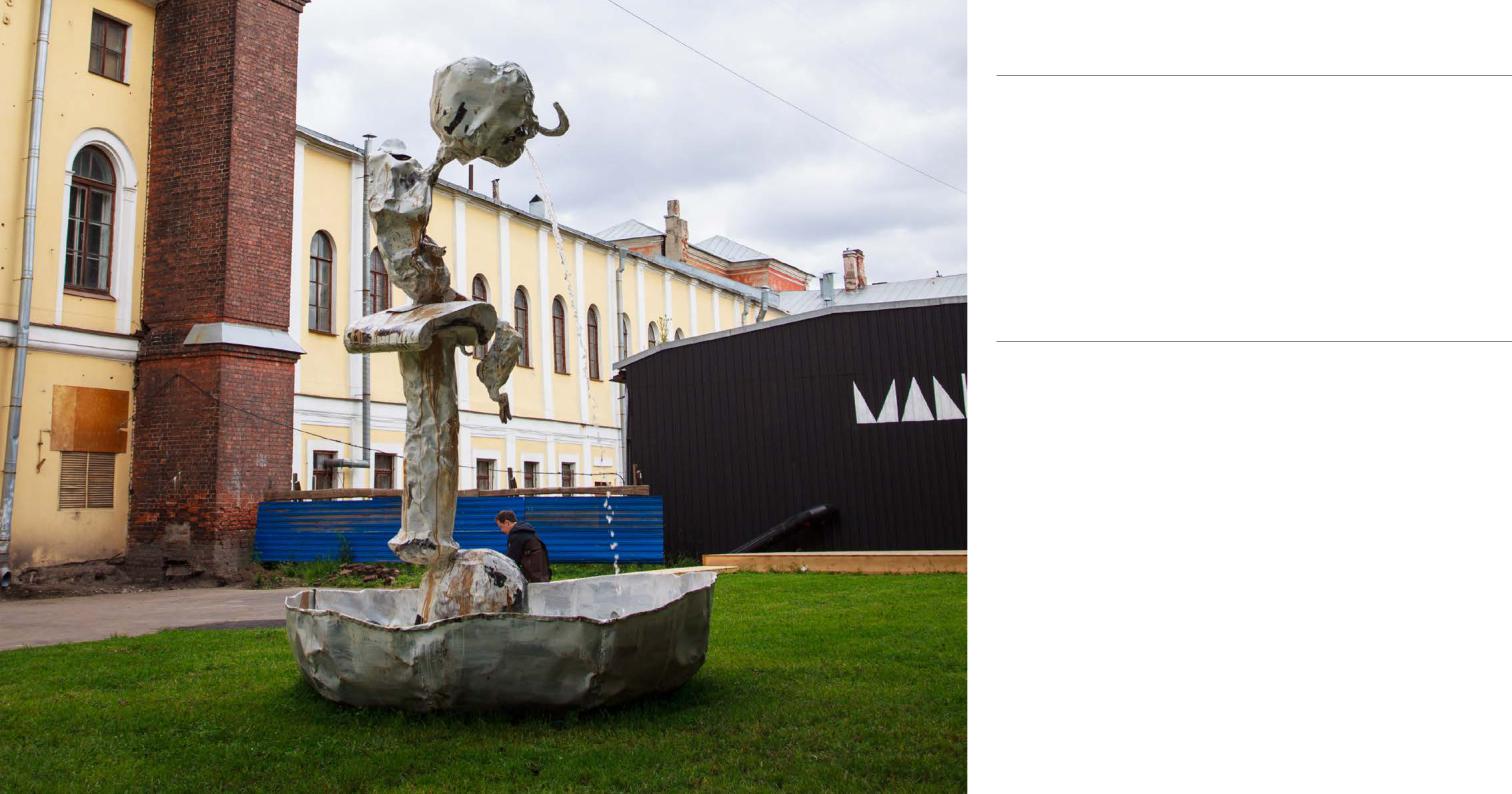
Иван Горшков / Ivan Gorshkov
Иван Горшков о своей работе: «Вот уже год как меня не покидает навязчивое желание производить фонтаны, похожие на скульптуры или инсталляции. В чем же секрет притягательности этого жанра? Один знакомый куратор как-то сказал мне: «Хорошо сделать просто скульптуру, но фонтан – это вызов!».
Родился в 1986 г. в Воронеже. В своей первой выставке «Паркур», представленной в рамках проекта СТАРТ, Иван Горшков выразил идею конфликта города и человека с помощью скульптур, отлитых из металла и отдалённо напоминающих человеческое тело. Пластичные фигуры скульптурной группы изображали новых героев улиц, вступающих в напряженное физическое взаимодействие с окружающей средой. Их тела в результате столкновения с городом становятся аморфными, неустойчивыми, но в то же время именно эта деформация создаёт ощущение движения, конфликта и преодоления. В своей новой работе для выставки Generation START Иван Горшков обращается к образу фонтана. Объект «Фонтан» будет представлен во дворе Кадетского корпуса.
Ivan Gorshkov about his work: “Now for a whole year I have been under the influence of a reoccurring idea – to make fountains reminiscent of sculptures or
installations. Why am I drawn to this genre? A curator I know once said to me: “It’s one thing to just make a sculpture, but a fountain is a real statement!”.
Born 1986, Voronezh. In his first exhibition “Parkur” at the START project space, Ivan Gorzhkov explored the idea of conflict between the city and people using sculptural figures cast in metal and vaguely reminiscent of the human body. The plastic figures of the sculptural group depicted the new heroes of the streets, frozen in a state of tension against the surrounding environment. Their bodies were the results of a clash with the city, becoming amorphous, unstable, becoming through this deformation a moving vector, always in conflict, always overcoming. In his new work for the Generation START exhibit Ivan Gorshkov explores the imagery of fountains. For the Generation START exhibition Ivan Gorshkov will present the object “The Fountain” in the courtyard of the Cadets unit.
Фонтан / The fountain
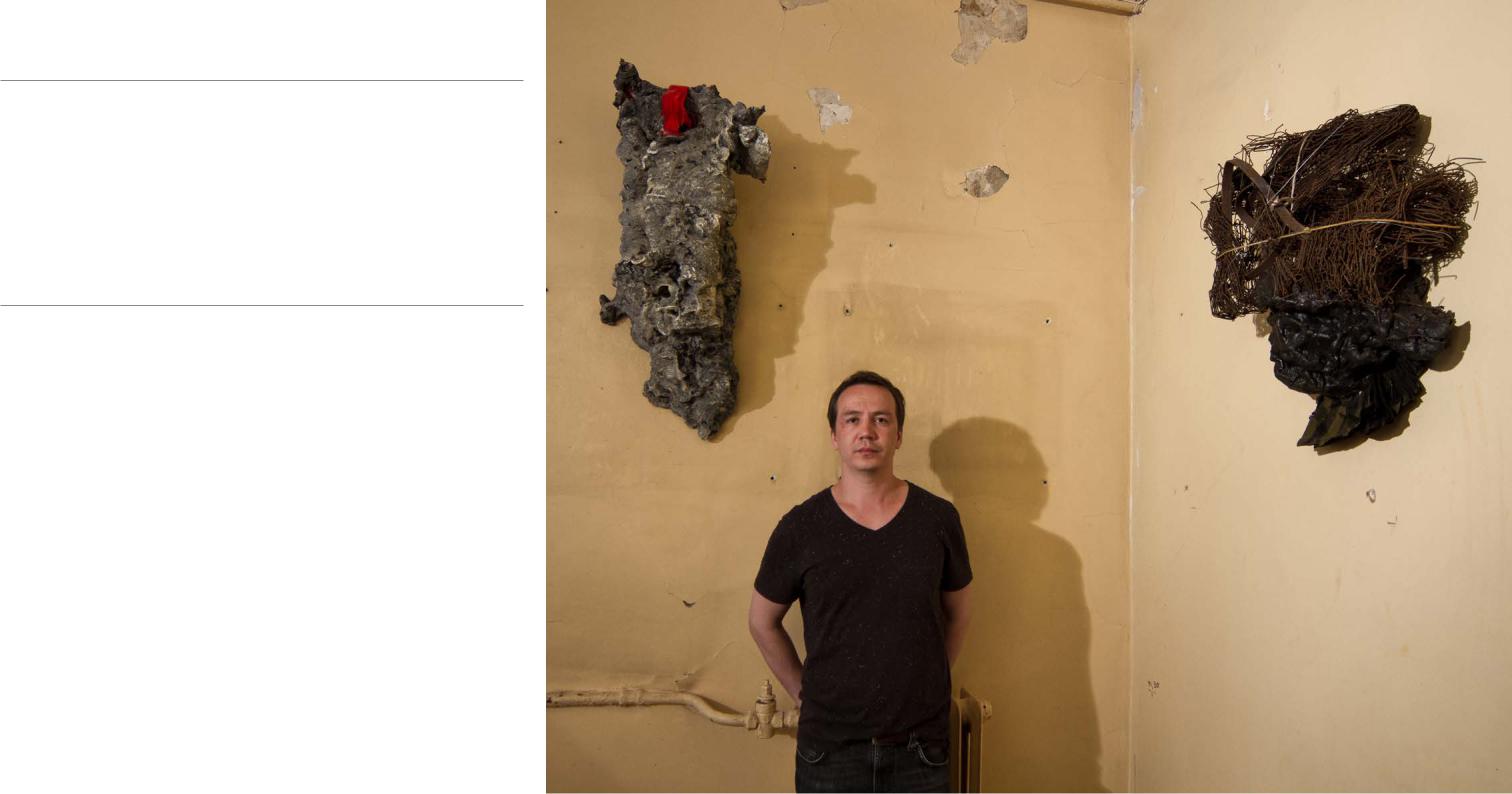
Александр Подгорный / Akexander Podgorniy
Александр Подгорный о выставке: «Однажды я увидел в развалинах здания XVIII века объекты, поразившие меня своими формами. Когда-то на территории этого здания находились сгоревшие хозяйственные постройки. Объекты, которые в основном состоят из продуктовых и фасовочных пакетов, испытали воздействие огня. Меня удивило, как природа создает удобные и органичные для нее объекты, перерабатывая на свой лад вещи, созданные человеком».
Родился в 1977 г. в Алдане (Якутия). Происхождение предметов на выставке Александра Подгорного «Находки» естественное – камешки, осколки стекла с берега Байкала, обгоревшие куски пластика. Представленные в виде ready-made, изготовленные природой, они привлекли его внимание как документальное свидетельство незаметного, на первый взгляд, взаимодействия природы и созданной человеком цивилизации.
Alexander Podgorniy about the exhibition: “Once I saw a decayed building from the XVIII century which amazed by it’s form. Th is building used to house burnt dwellings. The objects, which are mostly composed from plastic bags, were burnt by fire. I was surprised by how nature creates organic things, re-making human ones.
Born 1977 in Aldan (Yakutiya). The origin of the objects in Alexander Podgorniy’s exhibition “Findings” are from nature – rocks, bits of glass from the Baikal lake, burnt pieces of plastic. Presented as ready-mades, made by nature, these objects attracted his attention as being a symbol of the link between humanity and the natural world. Nature creates sculpture out of civilization’s garbage, beautiful and horrendous at the same time.
Без названия / Untitled
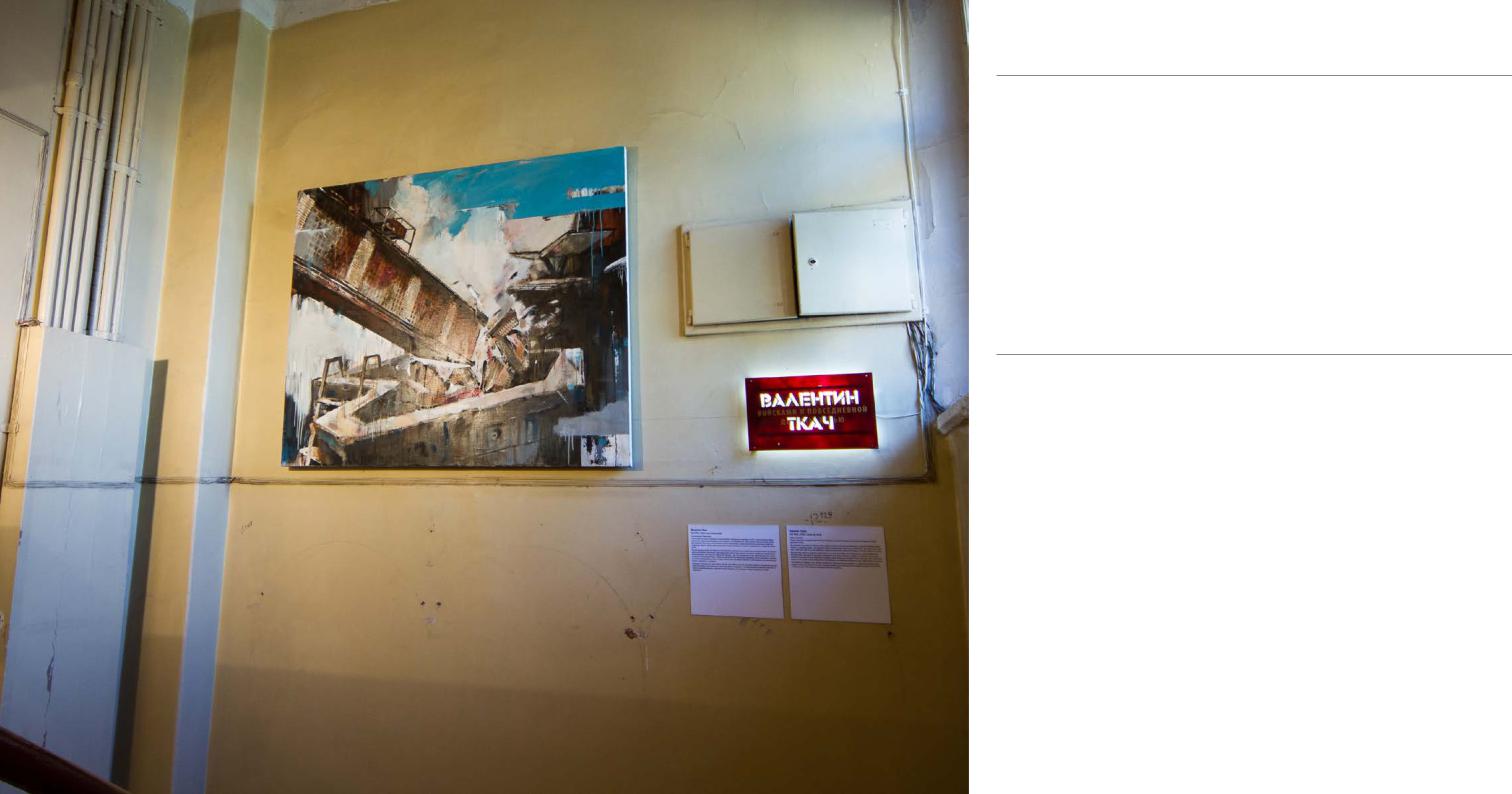
Валентин Ткач / Valentin Tkach
Валентин Ткач о выставке: «Таким я помню кино из детства: затемненный фон, нечеткое изображения и яркие всполохи света. В моих картинах важно не только то, что написано красками, но и следы того, что было стерто. Сочетание разномасштабных элементов индустриальной архитектуры должно усиливать ощущение нереальности происходящего».
Родился в 1974 г. в селе Деревянное (Карелия). Название проекта Vertigo (2010) отсылало к одноименному фильму Альфреда Хичкока, в котором режиссер впервые применил визуальный эффект головокружения для создания саспенса.
Ткач своей серией работ обращался к кинематографу не только ключевыми картинами («Кинозал», «Занавес»), но и общей атмосферой просмотра старого фильма в летнем кинотеатре. Изображение привычных объектов («Склад», «Бассейн», «Лестница») несло в себе эрозию времени – цвета поблекли, контуры размыты, пространство искажено настолько, что вызывает ощущение головокружения. В рамках В рамках выставки Generation START Валентин Ткач представит работу «Бассейн» из серии Vertigo.
Valentin Tkach about the exhibit: “This is the way I remember film from my childhood: a murky background, unfocused image and bright splashes of color. My paintings recreate that which was destroyed. Differently scaled elements of industrial architecture sharpen the sense of the impossibility of what is happening.”
Born 1974 in Derevyannoe (Kareliya). The title “Vertigo” (2010) was a reference to Alfred Hitchcock’s film of the same name in which the director first used the visual effect of vertigo to convey a sense of suspense. Valentin Tkach addressed film in his work not only by referencing actual movies (“The movietheatre”, “Curtain”) but by recreating the atmosphere of watching a movie in a Soviet summer theatre. The artist combined the expressive color abstraction with the sharp geometrics of Soviet modernist architecture. The imagery of everyday objects (“The storage”, “The pool”, “Stairs”) created a sense of the erosion of time – the colors were murky, hazy contours, glitches, the environment broken in such a way so as to make the viewer feel vertigo.
Бассейн / The pool
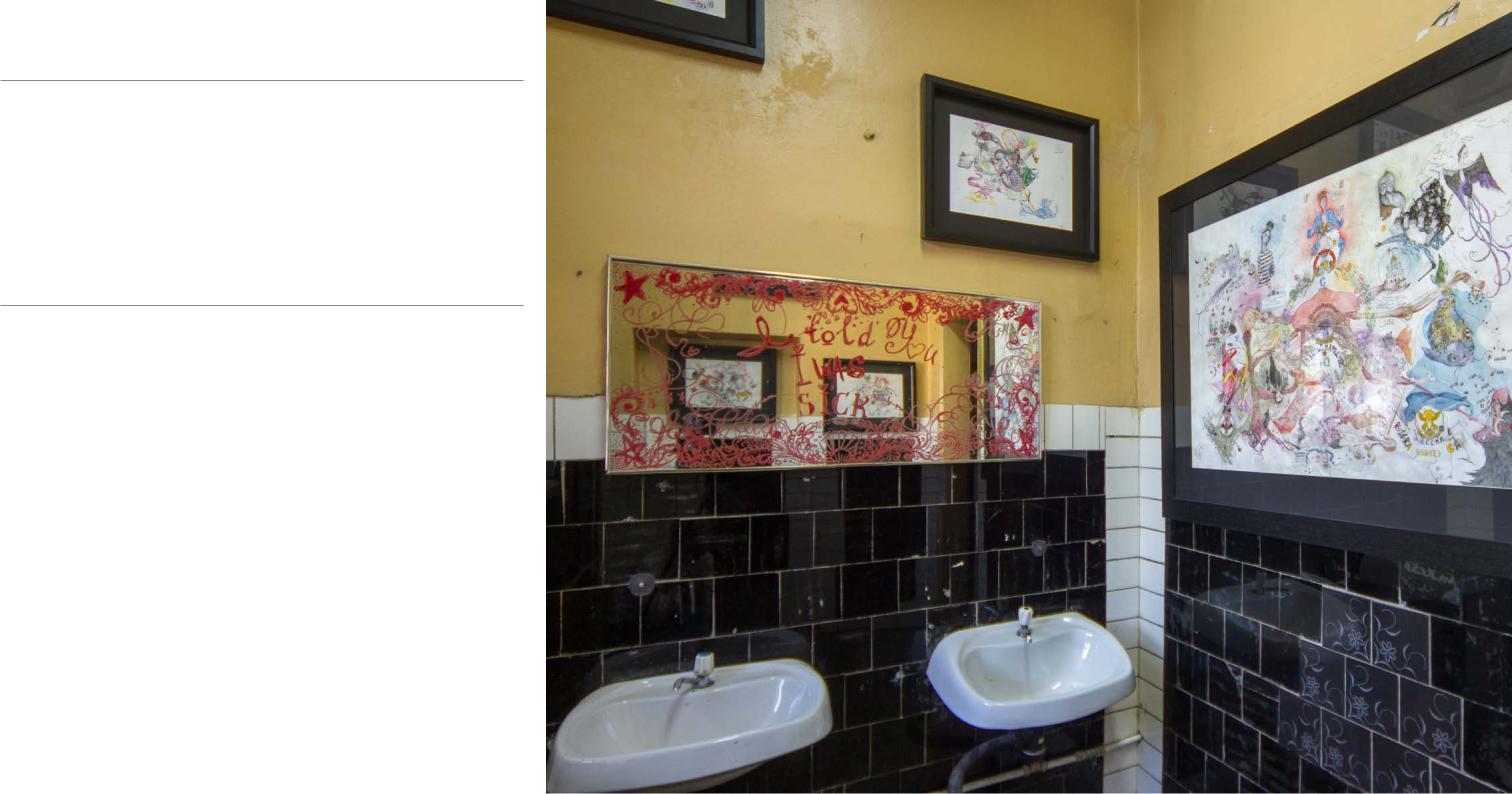
Татьяна Пёникер / Tatiana Peniker
Татьяна Пёникер о выставке: «Я всегда ставлю перед собой задачу максимально правдиво и натуралистично выплеснуть все свои эмоции и чувства, обнажить самые больные места. Внутри меня уже восемнадцать лет разворачивается мучительная война: с одной стороны, мне нравится все чистое и непорочное, с другой — жестокое и отвратительное».
Родилась в 1994 г. в Москве. В серии графических работ «Бессловесное признание» (2011) самая юная участница Generation START применила технику коллажа. Результат одновременно напоминал ученические рисунки в тетради и иллюстрации для фэнтези-литературы. Представительница поколения нулевых, выросшего в соцсетях, фиксировала свой поток сознания в автоматических рисунках и превращала их в объекты искусства. Серию картин дополняло огромное металлическое сердце с неоновой надписью «Stay».
Tatiana Peniker about “Wordless confession” (2011): “I always try to replicate my feelings and emotions as truthfully as possible, to show all of the most banal spaces within me. For 18 years I have been battling an internal war: on the one hand, I am drawn to everything pure and virgin, on the other, everything brutal and disgusting.”
Born 1994 in Moscow. In her series of graphic work “Wordless confession” the youngest of the Generation START artists (during her 2011 exhibition she was still at school) used the collage technique. The result was reminiscent of school doodles and fantasy illustration. Bosch can be said to be an influence, as well as Kandinsky and Salvador Dali. Tatiana in her interviews talked about the influence of Jake and Dinos Chapmen. As a representative to the generation of the 2000s, having grown up in the internet, she worked with her unconsciousness to create objects of art. The paintings were complemented with a huge metal heart and a neon sign – “Stay”.
Акварель и графика / Watercolor and Graphics
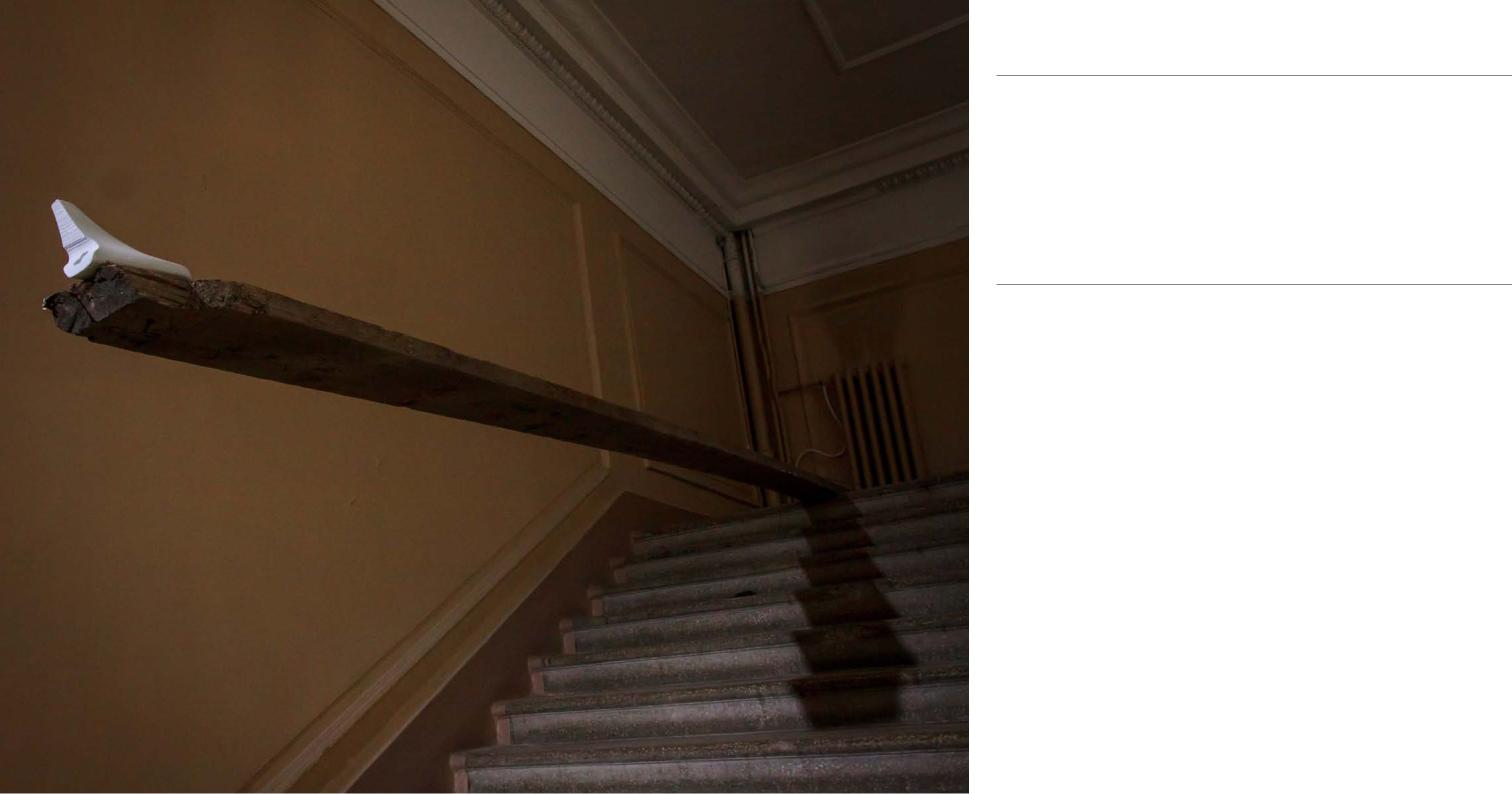
Евгений Дедов / Valentin Tkach
Евгений Дедов об инсталляции: «Определенное отношение к пространству вовлекает меня в лакуну смыслов. Мне интересно действие, при котором пространство разворачивает некий план пространства когнитивного, где предмет, его свойства, функция, материал становятся результатом интуиции этого пространства».
Родился в 1987 г. в Ленинграде. Евгений Дедов в своей дебютной инсталляции «Пять комнат» поставил перед собой масштабную задачу изобразить саму человеческую жизнь. Зритель проходил через пять последовательно соединённых друг с другом комнат, заполненных песком. Каждый прошедший через «Пять комнат» выносил из этого опыта что-то своё: кто-то переоценку ценностей, кто-то – песок в ботинках. Новая работа автора «Эхо» вовлекает зрителя в непосредственное взаимодействие с пространством Кадетского корпуса.
Evgeniy Dedov about his installation “Echo” (2014): “A certain attitude toward the space engages me in a pool of meanings of consciousness, materiality, social and intimate moments. I am interested in performing actions that make space produce a certain type of plan, one that is cognitive, where the object’s function becomes a result of the intuition of the space itself. I want to think about space as a tying force, one that defines the ability to combine various details, each of which reminds the viewer of something else.”
Born 1987 in Leningrad. Evgeniy Dedov in his debut installation “Five rooms” set himself the far-reaching goal of showing the scope of human life itself. The viewer walks through five consequent rooms filled with sand. Sand is the ancient symbol of how quickly time flows, entry into the room symbolizes birth, exit from the last of the rooms – death. The artist’s new work “Echo” engages the viewer with environment of the Cadets unit.
Эхо / The echo
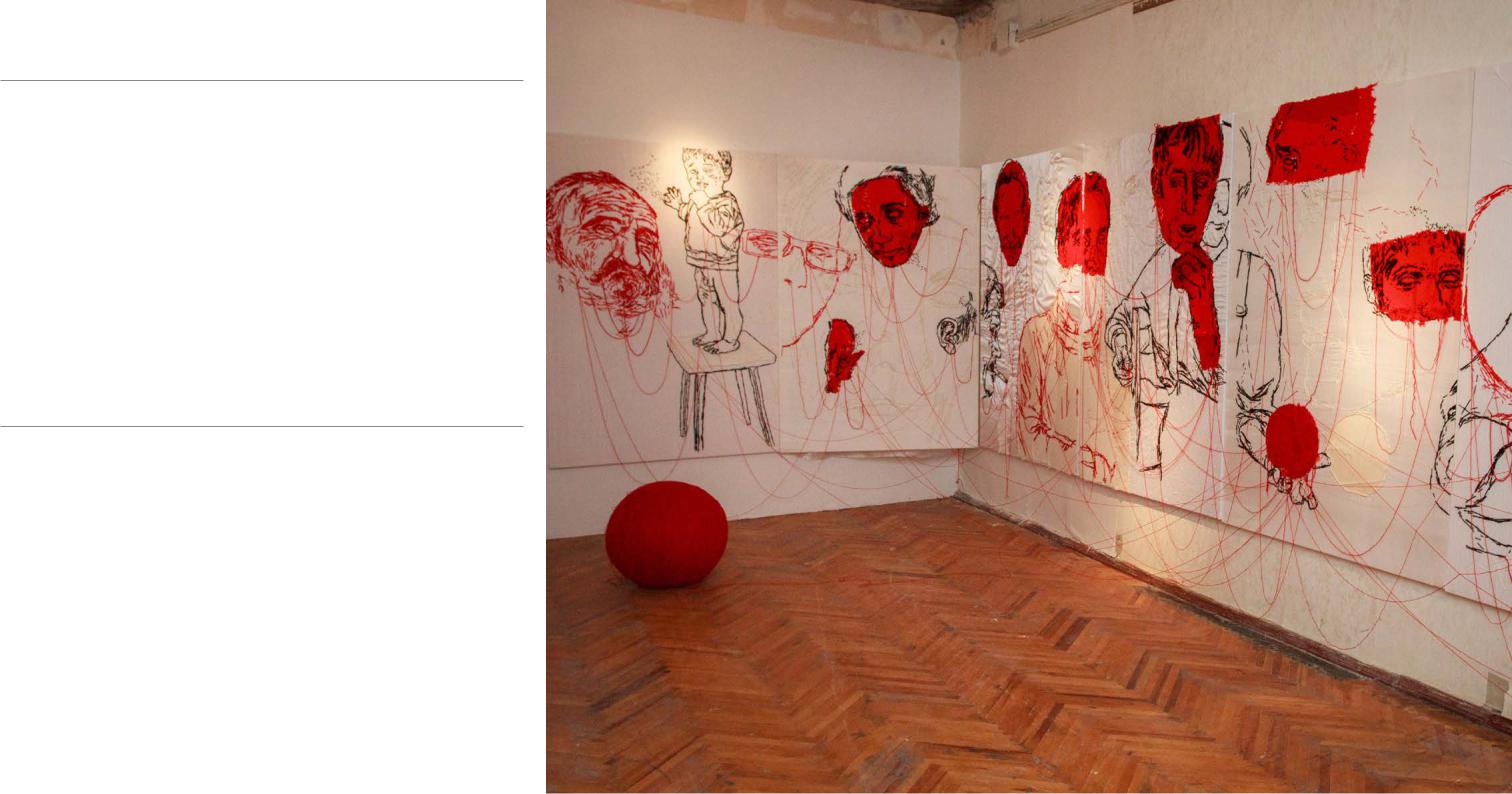
Татьяна Ахметгалиева / Tatiana Akhmetgalieva
Татьяна Ахметгалиева о выставке: «Сибирь — земля, связанная с материнским началом, отмеченная агрессивной роскошью природы – позволяет отыскать в себе некие таинственные голоса. Вряд ли это можно отнести к разряду эстетических переживаний — скорее это экзистенциальное прозрение. Они воспринимают свою данность как некую приговоренность к жизни в этой реальности, маются комплексом неполноценности и связаны по рукам и ногам полнейшей свободой, когда никто никому не обязан и никто никого не держит».
Родилась в 1983 г. в Кемерово. Финалист премии Кандинского 2010 г. в номинации «Молодой художник. Проект года», художник Galerie Forsblom (Хельсинки). В качестве художественного объекта для своей выставки «Стадия куколки» Татьяна Ахметгалиева использовала пряжу. Инсталляция представляет собой два монументальных текстильных панно, расположенных друг напротив друга. Картины словно «связаны» из разноцветной пряжи, которая, с одной стороны, выполняет функции краски, а с другой – выходит за пределы плоскости рисунка, клубками выкатываясь к ногам зрителей. Татьяна Пёникер о выставке: «Я всегда ставлю перед собой задачу максимально правдиво и натуралистично выплеснуть все свои эмоции и чувства, обнажить самые больные места. Внутри меня уже восемнадцать лет разворачивается мучительная война: с одной стороны, мне нравится все чистое и непорочное, с другой — жестокое и отвратительное».
Tatiana Akhmetgalieva about the exhibition: “Siberia is a land that is closely connected to the nature of the Mother, with a vicious and luxurious landscape. The environment is full of mysterious voices. This is not something that can be categorized as a purely aesthetical feeling, rather, it is existential. Siberian’s feel of their place in the world is closely connected to existentialism. They are sentenced to exist in this reality, caught up between the choking feeling of an inferiority complex and total freedom, when one owes others nothing and can leave anytime.
Born 1983 in Kemerovo. Finalist of the Kandinskiy Award 2010 in the “Young artist. Project of the year”. Represented by Galerie Forsblom (Helsinki). For her “The pupal stage” exhibition Tatiana Akhmetgalieva uses yarn to create her objects. The installation consists of two monumental textile panels placed opposite each other. The paintings appear to be knitted from differently colored yarn which performs the role of not only paint, but also as a material that breaks the picture plane. The yarn falls to the viewer’s feet. For the Generation START exhibition Tatiana Akhmetgalieva will reproduce the installation “The pupal stage”, presented in 2009 at the START project space.
Акварель и графика / Watercolor and Graphics
